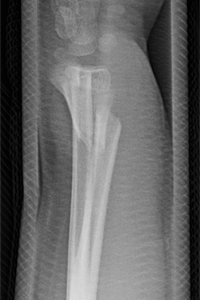The case(s)
You are seeing a pair of siblings that crashed into each other while jousting on their bikes. They were wearing helmets but both sustained forearm injuries. Both have swollen, tender forearms and you get X-Rays. And, no, there is not a BOGO discount.


The Diagnosis
Both patients have forearm fractures. Patient A has a buckle, or torus fracture. This occurs when the bone is compressed and the cortex buckles, often when the child falls on an outstretched hand (FOOSH). Patient B’s fracture is notably more angulated and represents diaphyseal fractures of both the radius and ulna with apex-volar angulation. It is also a complete fracture, since the cortex has been broken through.
Management
Patient A has a stable injury that requires splinting and pain relief. A volar or sugartong splint will suffice.
- Volar Splint (Courtesy WikiEM)
- Sugar Tong Splint (Courtesy WikiEM)
Torus fractures heal incredibly well and may actually do just as well with a removable splint as with a short arm cast (see Plint et al for more). Nevertheless, you must differentiate them from a Greenstick fracture (see below) since that one definitely needs a cast. Note that the Greenstick fracture is different than that of Patient B, since the cortex is not completely broken.

Greenstick fracture
Patient B obviously has the more significant injury. It will require reduction, perhaps with ketamine. General criteria for forearm fractures that DO NOT require reduction are as follows:
- Nondisplaced isolated radial shaft fractures with <15 to 20 degrees angulation can be splinted in a sugar tong splint or casted without reduction in kids under the age of 10 years. Physical function at six weeks in children randomized to reduction or casting initially was similar in a trial by Boutis et al.
- Minimally displaced radial shaft fractures with the following features can be immobilized without reduction
- Lateral shift <2mm
- Dorsal angulation <10 degrees
- Shortening of <2mm
- Bayonet apposition without angulation or rotational deformity in children <10 years
Fractures that DO require immediate closed reduction include
- Displaced fractures
- Greater than 20 degrees of angulation
When in doubt you can discuss any fracture with your friendly neighborhood Orthopod. In general children who are angulated >10 degrees and who are older than 10 years are candidates for closed reduction. Patients that don’t need reduction should be splinted and follow up with Orthopedics within the next 5-7 days.










